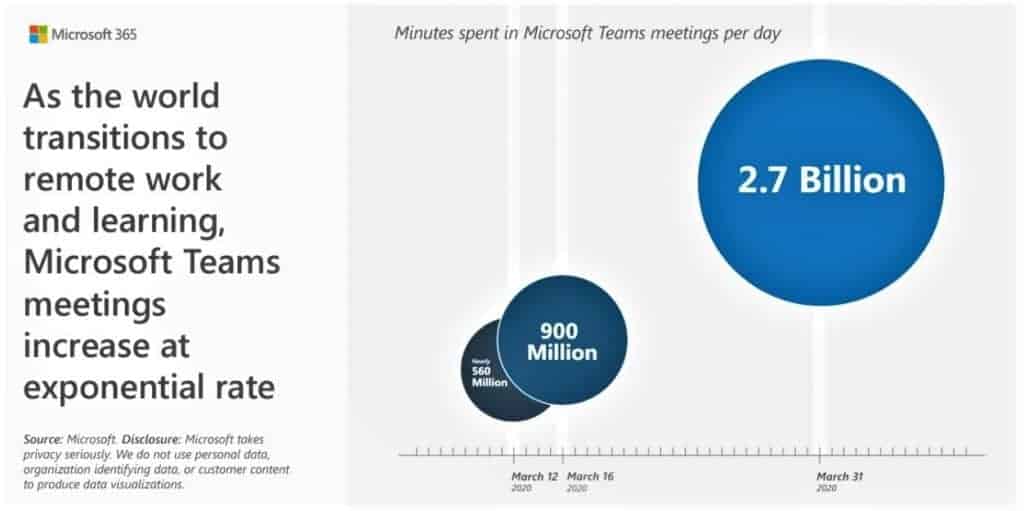Until a few months ago, remote work was a rare luxury among certain corporate employees. In the last few weeks, most companies have been forced to reassess policies and guidelines surrounding remote work, as well as pivot their short and long-term collaboration strategies to support an entirely remote workforce.
Turns out, with the right tools, setup and strategy, teams can be highly productive and successful without physically being in the same room. Unsurprisingly, Microsoft Teams has been a key leader in this transformation, doubling Teams usage in just a few weeks.
TRYANE CUSTOMER TRENDS
Here’s what we’re seeing in our platform –
1 The number of Teams is growing
Among our customers, there’s a 61% growth in overall teams created.
One of our customers added more than 1,000 teams since the beginning of the year. That’s almost 200 teams every week!
2 MS Teams usage has tripled
MS Teams are at the forefront of new collaboration practices.
Since the beginning of the year, we’ve seen a 3x increase in active users – overall activity among these users has grown more than 5x.
3 “Good” engagement is growing fastest
Document collaboration is a strong indicator of collaboration health, so we’re excited to see the highest growth and engagement there.
Teams® allows unlimited users to collaborate on a single document, with clear history and edit hierarchy. This ensures projects are transparent, with supporting documents easily discoverable, organized and up-to-date.
Here’s the breakdown of our customer activity growth –
– Document collaboration is up 25x
– Team discussions is up 12x
– Chats have increased by 50%
4 Most guests are left unattended
Guest user access has increased 61% across all teams as companies move client meetings and contract work online. Unfortunately, 55% of all guests have been inactive over the last 3 months.
It’s important to note that while an increase in access can indicate collaboration health, unmanaged external access can pose an internal security risk.
Learn more about how to easily manage guest access at scale.
OUR TAKEAWAYS
1 Teams is no longer a supplement
Everyone is working from home, so using Teams® is no longer a supplement for collaboration – it’s now a primary tool.
With the initial data we’re seeing, it’s likely that companies will have a harder time enforcing strict work from home policies once things normalize.
It’s becoming clear that with the right tools, employees are just as (if not more) productive working remotely. Those same tools can also help establish the social connections and collaboration efficiently that often comes from the physical proximity of working in an office.
2 The race to implementation
Companies are currently rushing to sustain remote collaboration. We’re seeing organizations pivot IT strategies at lightning speed and fast-tracking their MS Teams deployment months ahead of schedule.
The upside? You quickly set up basic infrastructure for remote collaboration and MS Teams is easy-to-use off-the-bat.
The downside? Launching MS Teams prematurely can lead to difficulty managing your users down-the-line.
Without careful planning, training, and enforcement of best practice, employees create their own rules of engagement. IT professionals are finding that quick deployment quickly leads to a 1:1 ratio of teams to meetings and rapid increases in unsanctioned clutter.
3 Clutter and its aftermath
Teams usage is scaling exponentially, but a lack in deployment strategy and skipped steps are laying the groundwork for clutter and inefficiencies a few months from now.
Given the pace of team creation, many organizations will soon have thousands of inactive teams. Inactive teams add noise to your ecosystem and increase the time it takes your users to find a particular piece of information – which becomes very costly for a company, time-wise.
4 Inactivity can be a security risk
From what we’ve seen, the percentage of inactive teams and inactive guests correlates to overall organization security.
Guests (consultants, clients, etc) are usually invited to collaborate on a project-by-project basis, but many companies approve blanket access for external collaborators, without thinking through an engagement and management strategy. A high percentage of inactive guests indicates that a high percentage of external collaborators may still have access to internal documents and confidential conversations.
The best way to keep your teams secure is to put a proactive guest management policy in place prior to deployment. If you’re working on retroactive cleanup, Tryane for Teams can help you identify idle guests and set up automations to bulk-revoke access once it’s no longer needed.
Learn more about how you can gather insights and implement best practice across your Teams®.

